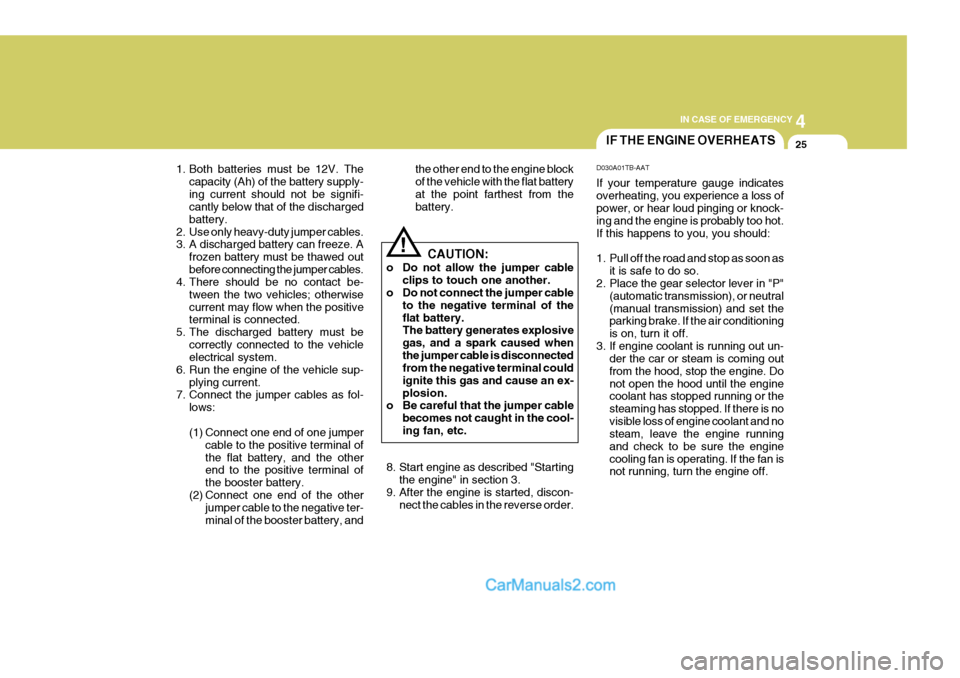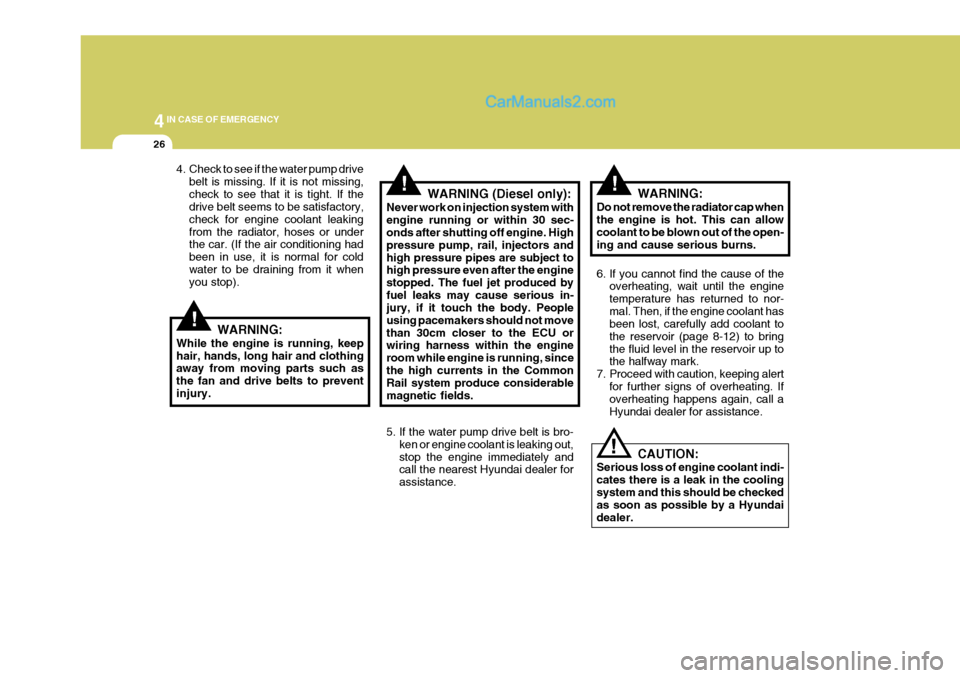2005 Hyundai H-1 (Grand Starex) engine overheat
[x] Cancel search: engine overheatPage 122 of 205

4
CORROSION PREVENTION AND APPEARANCE CARE
21
4
IN CASE OF EMERGENCY
21BLEEDING THE FUEL SYSTEM
CAUTION:
If overheating should occur when towing, (temperature gauge reads near red zone), taking the followingaction may reduce or eliminate the problem.
1. Turn off the air conditioner.
2. Reduce highway speed.
3. Select a lower gear when going uphill.
4. While in stop and go traffic, place
the gear selection in park or neu-tral and idle the engine at a higher speed.
! E090A01P-GAT (Diesel Motor) The fuel system should be bled to remove air as described in the illustra- tion if the fuel supply is exhaustedduring travel, when the fuel filter is replaced, or if the vehicle is not used for a long time.
1. Loosen the air plug at the top of the
fuel filter. E090A01P
13.Avoid holding the brake pedal down
too long or too frequently. This could cause the brakes to overheat, re- sulting in reduced braking efficiency.
14.When going down a hill, shift into a
lower gear and use the engine brak-ing effect. When ascending a long grade, downshift the transmissionto a lower gear and reduce speed to reduce chances of engine over- loading and/or overheating.
15.If you have to stop while going uphill, do not hold the vehicle inplace by pressing on the accelera-tor. This can cause the automatic transmission to overheat. Use the parking brake or footbrake.
NOTE: When towing, check transmission fluid more frequently.
Page 126 of 205

4
CORROSION PREVENTION AND APPEARANCE CARE
25
4
IN CASE OF EMERGENCY
25IF THE ENGINE OVERHEATS
CAUTION:
o Do not allow the jumper cable clips to touch one another.
o Do not connect the jumper cable
to the negative terminal of the flat battery. The battery generates explosive gas, and a spark caused whenthe jumper cable is disconnected from the negative terminal could ignite this gas and cause an ex-plosion.
o Be careful that the jumper cable
becomes not caught in the cool-ing fan, etc.
! D030A01TB-AAT If your temperature gauge indicates overheating, you experience a loss of power, or hear loud pinging or knock- ing and the engine is probably too hot.If this happens to you, you should:
1. Pull off the road and stop as soon as
it is safe to do so.
2. Place the gear selector lever in "P"
(automatic transmission), or neutral (manual transmission) and set the parking brake. If the air conditioning is on, turn it off.
3. If engine coolant is running out un- der the car or steam is coming outfrom the hood, stop the engine. Donot open the hood until the engine coolant has stopped running or the steaming has stopped. If there is novisible loss of engine coolant and no steam, leave the engine running and check to be sure the enginecooling fan is operating. If the fan is not running, turn the engine off.
the other end to the engine block of the vehicle with the flat batteryat the point farthest from the battery.
8. Start engine as described "Starting the engine" in section 3.
9. After the engine is started, discon- nect the cables in the reverse order.
1. Both batteries must be 12V. The
capacity (Ah) of the battery supply- ing current should not be signifi- cantly below that of the discharged battery.
2. Use only heavy-duty jumper cables.
3. A discharged battery can freeze. A
frozen battery must be thawed out before connecting the jumper cables.
4. There should be no contact be-
tween the two vehicles; otherwisecurrent may flow when the positive terminal is connected.
5. The discharged battery must be correctly connected to the vehicleelectrical system.
6. Run the engine of the vehicle sup- plying current.
7. Connect the jumper cables as fol-
lows:
(1) Connect one end of one jumper cable to the positive terminal of the flat battery, and the other end to the positive terminal of the booster battery.
(2) Connect one end of the other jumper cable to the negative ter-minal of the booster battery, and
Page 127 of 205

44IN CASE OF EMERGENCY
26
4. Check to see if the water pump drivebelt is missing. If it is not missing, check to see that it is tight. If the drive belt seems to be satisfactory, check for engine coolant leakingfrom the radiator, hoses or under the car. (If the air conditioning had been in use, it is normal for coldwater to be draining from it when you stop).
!WARNING:
While the engine is running, keep hair, hands, long hair and clothing away from moving parts such as the fan and drive belts to preventinjury.
!WARNING (Diesel only):
Never work on injection system with engine running or within 30 sec- onds after shutting off engine. High pressure pump, rail, injectors andhigh pressure pipes are subject to high pressure even after the engine stopped. The fuel jet produced byfuel leaks may cause serious in- jury, if it touch the body. People using pacemakers should not movethan 30cm closer to the ECU or wiring harness within the engine room while engine is running, sincethe high currents in the Common Rail system produce considerable magnetic fields.
5. If the water pump drive belt is bro- ken or engine coolant is leaking out, stop the engine immediately and call the nearest Hyundai dealer for assistance.!WARNING:
Do not remove the radiator cap when the engine is hot. This can allow coolant to be blown out of the open- ing and cause serious burns.
6. If you cannot find the cause of the overheating, wait until the engine temperature has returned to nor-mal. Then, if the engine coolant has been lost, carefully add coolant to the reservoir (page 8-12) to bringthe fluid level in the reservoir up to the halfway mark.
7. Proceed with caution, keeping alert for further signs of overheating. Ifoverheating happens again, call a Hyundai dealer for assistance.
CAUTION:
Serious loss of engine coolant indi-cates there is a leak in the coolingsystem and this should be checked as soon as possible by a Hyundai dealer.
!
Page 203 of 205

10INDEX
4
I IF THE ENGINE OVERHEATS ................................ 4-25
IF THE ENGINE WILL NOT START .......................4-23
IF YOU HAVE A FLAT TIRE ..................................... 4-6
IGNITION SWITCH .................................................... 3-3
ILLUMINATED IGNITION SWITCH .........................1-11
IMMOBILIZER SYSTEM ............................................ 1-6
INCLI NOMETER ....................................................... 2-17
INSTALLATION OF ACCESSORIES ......................... 1-4
INSTRUMENT CLUSTER AND
INDICATOR LIGHTS ............................................... 2-2
INSTRUMENTS PANEL LIGHT CONTROL (RHEOSTAT) ......................................................... 2-24
INTERIOR LIGHT ..................................................... 2-28
J
JACK ........................................................................... 4-2JUMP STARTING ..................................................... 4-24
K
KEYS ........................................................................... 1-6 KEY POSITI ONS ........................................................ 3-3
L
LOADING .................................................................. 3-22
LOCKING DIFFERENTIAL ....... ................................3-31
LUBRICATION CHART .............................................. 9-4 MMAINTENANCE INTERVALS
..................................... 6-2
MAKING A FLAT SEAT .... .......................................1-36
MANUAL TRANSMISSION .................. ...................... 3-7
MEASUREMENT ........................................................ 9-2MULTI-FUNCTION LIGHT SWITCH Daytime Running Lights .................... ..................... 2-20
Headlight Flasher ................................................... 2-20
Headlight Switch .................................................... 2-19
High-beam Switch .................................................. 2-20
Lane Change Si gnal .............................................. 2-19
Parking Light Auto Cut .................. ........................ 2-20
Turn Signal Switch................................................. 2-19
MULTIMETER Altimeter ................................................................. 2-18
Inclinometer ............................................................ 2-17
Thermometer .......................................................... 2-17
OODOMETER/TRIP ODOMETER ..............................2-14
OPERATING THE SUNROOF SYSTEM .................2-31
OUTSIDE REARVIEW MIRROR ..............................2-34
OUTSIDE REARVIEW MIRROR HEATER ..............2-35
OVERDRIVE SWITCH ............................................. 3-12
OVERHEAD AIR COND ITIONING........................... 2-47